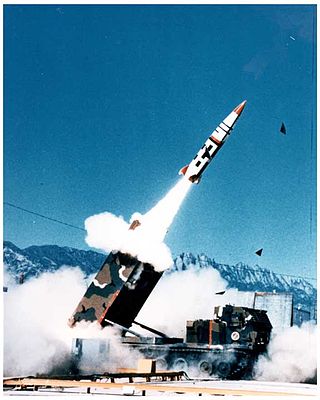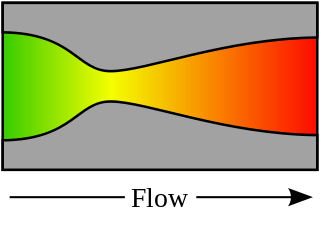
A missile is an airborne ranged weapon capable of self-propelled flight aided usually by a propellant, jet engine or rocket motor.

A rocket is a vehicle that uses jet propulsion to accelerate without using the surrounding air. A rocket engine produces thrust by reaction to exhaust expelled at high speed. Rocket engines work entirely from propellant carried within the vehicle; therefore a rocket can fly in the vacuum of space. Rockets work more efficiently in a vacuum and incur a loss of thrust due to the opposing pressure of the atmosphere.

A solid-propellant rocket or solid rocket is a rocket with a rocket engine that uses solid propellants (fuel/oxidizer). The earliest rockets were solid-fuel rockets powered by gunpowder; The inception of gunpowder rockets in warfare can be credited to ancient Chinese ingenuity, and in the 13th century, the Mongols played a pivotal role in facilitating their westward adoption.

A hybrid-propellant rocket is a rocket with a rocket motor that uses rocket propellants in two different phases: one solid and the other either gas or liquid. The hybrid rocket concept can be traced back to the early 1930s.
The SM-65 Atlas was the first operational intercontinental ballistic missile (ICBM) developed by the United States and the first member of the Atlas rocket family. It was built for the U.S. Air Force by the Convair Division of General Dynamics at an assembly plant located in Kearny Mesa, San Diego.

A model rocket is a small rocket designed to reach low altitudes and be recovered by a variety of means.

A rocket engine uses stored rocket propellants as the reaction mass for forming a high-speed propulsive jet of fluid, usually high-temperature gas. Rocket engines are reaction engines, producing thrust by ejecting mass rearward, in accordance with Newton's third law. Most rocket engines use the combustion of reactive chemicals to supply the necessary energy, but non-combusting forms such as cold gas thrusters and nuclear thermal rockets also exist. Vehicles propelled by rocket engines are commonly used by ballistic missiles and rockets. Rocket vehicles carry their own oxidiser, unlike most combustion engines, so rocket engines can be used in a vacuum to propel spacecraft and ballistic missiles.
DRDC Valcartier is a major Canadian military research station at Canadian Forces Base Valcartier, Quebec, one of nine centres making up Defence Research and Development Canada (DRDC).

A liquid-propellant rocket or liquid rocket utilizes a rocket engine burning liquid propellants. (Alternate approaches use gaseous or solid propellants.) Liquids are desirable propellants because they have reasonably high density and their combustion products have high specific impulse (Isp). This allows the volume of the propellant tanks to be relatively low.

Titan IV was a family of heavy-lift space launch vehicles developed by Martin Marietta and operated by the United States Air Force from 1989 to 2005. Launches were conducted from Cape Canaveral Air Force Station, Florida and Vandenberg Air Force Base, California.
Motors for model rockets and high-powered rockets are classified by total impulse into a set of letter-designated ranges, from ⅛A up to O. The total impulse is the integral of the thrust over burn time.

A tactical ballistic missile (TBM), or battlefield range ballistic missile (BRBM), is a ballistic missile designed for short-range battlefield use. Typically, range is less than 300 kilometres (190 mi). Tactical ballistic missiles are usually mobile to ensure survivability and quick deployment, as well as carrying a variety of warheads to target enemy facilities, assembly areas, artillery, and other targets behind the front lines. Warheads can include conventional high explosive, chemical, biological, or nuclear warheads. Typically tactical nuclear weapons are limited in their total yield compared to strategic nuclear weapons.
Amateur rocketry, sometimes known as experimental rocketry or amateur experimental rocketry, is a hobby in which participants experiment with fuels and make their own rocket motors, launching a wide variety of types and sizes of rockets. Amateur rocketeers have been responsible for significant research into hybrid rocket motors, and have built and flown a variety of solid, liquid, and hybrid propellant motors.
Rocket candy, or R-Candy, is a type of rocket propellant for model rockets made with a form of sugar as a fuel, and containing an oxidizer. The propellant can be divided into three groups of components: the fuel, the oxidizer, and the (optional) additive(s). In the past, sucrose was most commonly used as fuel. Modern formulations most commonly use sorbitol for its ease of production. The most common oxidizer is potassium nitrate (KNO3). Potassium nitrate is most commonly found in tree stump remover. Additives can be many different substances, and either act as catalysts or enhance the aesthetics of the liftoff or flight. A traditional sugar propellant formulation is typically prepared in a 65:35 (13:7) oxidizer to fuel ratio.

A rocket engine nozzle is a propelling nozzle used in a rocket engine to expand and accelerate combustion products to high supersonic velocities.
Ammonium perchlorate composite propellant (APCP) is a solid-propellant rocket fuel. It differs from many traditional solid rocket propellants such as black powder or zinc-sulfur, not only in chemical composition and overall performance but also by being cast into shape, as opposed to powder pressing as with black powder. This provides manufacturing regularity and repeatability, which are necessary requirements for use in the aerospace industry.

Rocket propellant is the reaction mass of a rocket. This reaction mass is ejected at the highest achievable velocity from a rocket engine to produce thrust. The energy required can either come from the propellants themselves, as with a chemical rocket, or from an external source, as with ion engines.

The RTV-A-3 NATIV was an experimental missile developed by North American Aviation for the United States Air Force in the late 1940s to test and evaluate guided missile technologies. The North American Test Instrumentation Vehicle (NATIV) was developed as part of the MX-770 program which was created towards the end of WWII with the intent of developing a long range missile.

Skokie was a family of research vehicles developed by the Cook Electric Co. for the United States Air Force during the mid to late 1950s. Launched from a B-29 bomber, Skokie 1 was an unpowered, ballistic vehicle, while Skokie 2 was rocket-propelled; both were used for evaluating and testing high-speed parachute recovery systems.
Hybrid rocket fuel regression refers to the process by which the fuel grain of a hybrid-propellant rocket is converted from a solid to a gas that is combusted. It encompasses the regression rate, the distance that the fuel surface recedes over a given time, as well as the burn area, the surface area that is being eroded at a given moment.
















